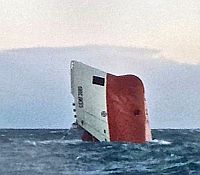 In January of 2015, we posted about the capsize and sinking of the Cyprus-registered cement carrier MV Cemfjord while attempting to navigate the Pentland Firth in extremely rough weather. Eight officers and crew aboard died in the sinking. The UK’s Marine Accident Investigation Branch (MAIB) issued its report on the casualty stating that the sinking could have been avoided if the captain sought refugee rather than continuing.
In January of 2015, we posted about the capsize and sinking of the Cyprus-registered cement carrier MV Cemfjord while attempting to navigate the Pentland Firth in extremely rough weather. Eight officers and crew aboard died in the sinking. The UK’s Marine Accident Investigation Branch (MAIB) issued its report on the casualty stating that the sinking could have been avoided if the captain sought refugee rather than continuing.
In his statement to the media, Steve Clinch, The Chief Inspector of Marine Accidents stated:
The MAIB investigation found that Cemfjord capsized in extraordinarily violent sea conditions; a fatal hazard that was predictable and could have been avoided. The decision to enter the Pentland Firth, rather than seek shelter, was almost certainly a result of poor passage planning, an underestimation of the severity of the conditions and perceived or actual commercial pressure to press ahead with the voyage. Critically, this decision will also have been underpinned by an unwillingness to alter course across the heavy seas after the experience of a cement cargo shift in similar circumstances about 3 months before the accident. The appalling conditions and rapid nature of the capsize denied the crew an opportunity to issue a distress message or to escape from their ship.
Shortly after the sinking, questions were raised as to whether the ship should have been allowed to sail at all. The ship suffered several mechanical deficiencies and its operation had been limited to coastal waters by the Cypriot registry. This limitation still allowed the Cemfjord to sail in the Pentland Firth, an area notorious for extremely violent seas.
Clinch also commented on the safety waivers granted by the Cypriots.
Although not a causal factor of the accident, it was also established that Cemfjord was only at sea because of Flag State approved exemptions from safety regulations. This tragic accident is a stark reminder of the hazards faced by mariners at sea and the factors that can influence decision making in such treacherous circumstances.

It’s worth reading the report. The loss doesn’t seem to be related much to mechanical problems with the ship (although the “lifeboat” situation was truly horrific) as a decision by the master to proceed through an extreme (perhaps worst case) wind-vs-current situation that was exacerbated as the vessel ended up with an unfavorable heading in order to make its intended course.
The decision to proceed was down to contractual obligations colliding with a series of delays while loading the ship. The same master had often in the past delayed passage through the particular firth in question, knowing full well the beating the ship could take by trying to sail to a schedule. In this case pressure to proceed was perhaps too much.
Upshot: the ship was rolled hard, past 30 degrees, meaning the cargo of cement moved and ended the story.
Awful.
What’s weird about this particular case is that the ship owners don’t seem to be the usual poster-child for negligent management. Some corners were cut but by no means anything nearly as bad as other cases, with the owners seemingly trying to do the right thing while facing an impossible deployment schedule.
I’ll just add, MAIB reports are a fantastic resource to feed the mind, during idle periods when we should be imagining what might go wrong.